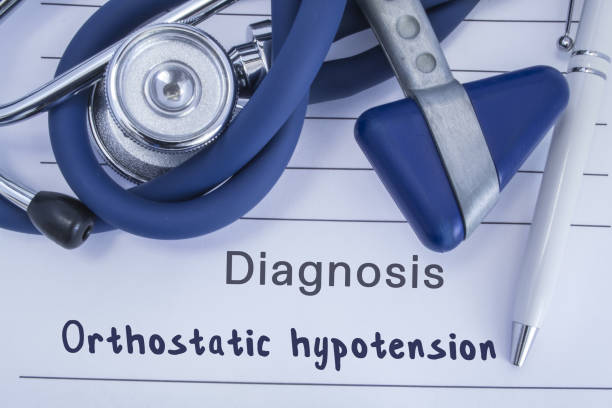A drop of 20 millimeters of mercury (mm Hg) in the top number (systolic blood pressure) within 2 to 5 minutes of standing is a sign of orthostatic hypotension. A drop of 10 mm Hg in the bottom number (diastolic blood pressure) within 2 to 5 minutes of standing also indicates orthostatic hypotension.
Orthostatic hypertension refers to an increase in the blood pressure upon assuming an upright posture. This clinical condition has been understudied and is often underappreciated in clinical practice probably because of its unfamiliarity to many clinicians including subspecialists.
Symptoms
The most common symptom of orthostatic hypotension is lightheadedness or dizziness when standing after sitting or lying down. Symptoms usually last less than a few minutes. Orthostatic hypotension signs and symptoms include:- Lightheadedness or dizziness upon standing
- Blurry vision
- Weakness
- Fainting (syncope)
- Confusion
When to see a doctor
Occasional dizziness or lightheadedness can be minor — triggered by mild dehydration, low blood sugar or overheating. Dizziness or lightheadedness can also result from standing after sitting for a long time. If these symptoms happen only occasionally, there's likely no cause for concern. It's important to see a health care provider for frequent symptoms of orthostatic hypotension. Losing consciousness, even for just a few seconds, is serious. It requires seeing a provider right away. Keep a record of your symptoms, when they occurred, how long they lasted and what you were doing at the time. Tell your care provider if symptoms occur at times that could be dangerous, such as while driving.Causes
When standing from a sitting or lying position, gravity causes blood to collect in the legs and belly. Blood pressure drops because there's less blood flowing back to the heart. Usually, special cells (baroreceptors) near the heart and neck arteries sense this lower blood pressure. The baroreceptors send signals to the brain. This tells the heart to beat faster and pump more blood, which evens out blood pressure. These cells also narrow the blood vessels and increase blood pressure. Orthostatic hypotension occurs when something interrupts the body's process of dealing with the low blood pressure. Many conditions can cause orthostatic hypotension, including:- Dehydration. Fever, vomiting, not drinking enough fluids, severe diarrhea and strenuous exercise with a lot of sweating can all lead to dehydration. Dehydration decreases blood volume. Mild dehydration can cause symptoms of orthostatic hypotension, such as weakness, dizziness and fatigue.
- Heart problems. Some heart conditions that can lead to low blood pressure include extremely low heart rate (bradycardia), heart valve problems, heart attack and heart failure. These conditions prevent the body from quickly pumping more blood when standing up.
- Endocrine problems. Thyroid conditions, adrenal insufficiency (Addison's disease) and low blood sugar (hypoglycemia) can cause orthostatic hypotension. So can diabetes, which can damage the nerves that help send signals that control blood pressure.
- Nervous system disorders. Some nervous system disorders, such as Parkinson's disease, multiple system atrophy, Lewy body dementia, pure autonomic failure and amyloidosis, can disrupt the body's ability to control blood pressure.
- Eating meals. Some people have low blood pressure after eating meals (postprandial hypotension). This condition is more common in older adults.
Risk factors
The risk factors for orthostatic hypotension include:- Age. Orthostatic hypotension is common in those who are age 65 and older. Special cells (baroreceptors) near the heart and neck arteries that control blood pressure can slow as you age. It also can be harder for an aging heart to speed up to make up for drops in blood pressure.
- Medications. These include medications used to treat high blood pressure or heart disease, such as diuretics, alpha blockers, beta blockers, calcium channel blockers, angiotensin-converting enzyme (ACE) inhibitors and nitrates. Other medications that can increase the risk of orthostatic hypotension include medications used to treat Parkinson's disease, certain antidepressants, certain antipsychotics, muscle relaxants, medications to treat erectile dysfunction and narcotics.
- Certain diseases. Diseases that can increase the risk of low blood pressure include some heart conditions, such as heart valve problems, heart attack and heart failure. They also include certain nervous system disorders, such as Parkinson's disease. And they include diseases that cause nerve damage (neuropathy), such as diabetes.
- Heat exposure. Being in a hot environment can cause heavy sweating and possibly dehydration, which can lower blood pressure and trigger orthostatic hypotension.
- Bed rest. Staying in bed for a long time because of an illness or injury can cause weakness. This can lead to orthostatic hypotension.
- Alcohol. Drinking alcohol can increase the risk of orthostatic hypotension.
Complications
Persistent orthostatic hypotension can cause serious complications, especially in older adults. These include:- Falls. Falling as a result of fainting is a common complication in people with orthostatic hypotension.
- Stroke. The swings in blood pressure from standing and sitting as a result of orthostatic hypotension can be a risk factor for stroke due to the reduced blood supply to the brain.
- Cardiovascular diseases. Orthostatic hypotension can be a risk factor for cardiovascular diseases and complications, such as chest pain, heart failure or heart rhythm problems.







